Solar eclipse of February 25, 1971
A partial solar eclipse occurred on February 25, 1971 with a magnitude of 0.7872. A solar eclipse occurs when the Moon passes between Earth and the Sun, thereby totally or partly obscuring the image of the Sun for a viewer on Earth. A partial solar eclipse occurs in the polar regions of the Earth when the center of the Moon's shadow misses the Earth. In this partial solar eclipse, the moon covered 78.7% of the sun.
| Solar eclipse of February 25, 1971 | |
|---|---|
 Map | |
| Type of eclipse | |
| Nature | Partial |
| Gamma | 1.1188 |
| Magnitude | 0.7872 |
| Maximum eclipse | |
| Coordinates | 61.4°N 33.5°W |
| Times (UTC) | |
| Greatest eclipse | 9:38:07 |
| References | |
| Saros | 149 (18 of 71) |
| Catalog # (SE5000) | 9444 |
Related eclipses
Solar eclipses of 1968–1971
This eclipse is a member of a semester series. An eclipse in a semester series of solar eclipses repeats approximately every 177 days and 4 hours (a semester) at alternating nodes of the Moon's orbit.[1]
| Solar eclipse series sets from 1968–1971 | ||||||
|---|---|---|---|---|---|---|
| Ascending node | Descending node | |||||
| Saros | Map | Gamma | Saros | Map | Gamma | |
| 119 | 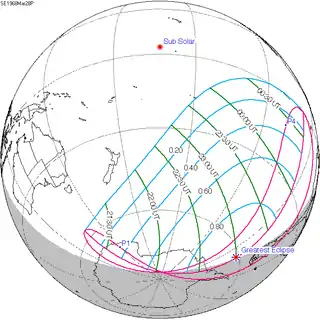 1968 March 28 Partial | -1.03704 | 124 |  1968 September 22 Total | 0.94507 | |
| 129 | 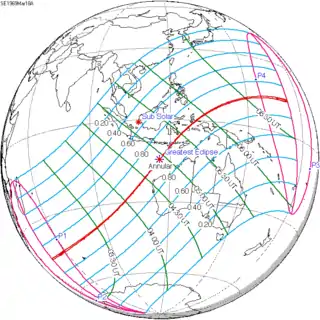 1969 March 18 Annular | -0.27037 | 134 |  1969 September 11 Annular | 0.22014 | |
| 139 |  1970 March 7 Total | 0.44728 | 144 |  1970 August 31 Annular | -0.53640 | |
| 149 |  1971 February 25 Partial | 1.11876 | 154 | 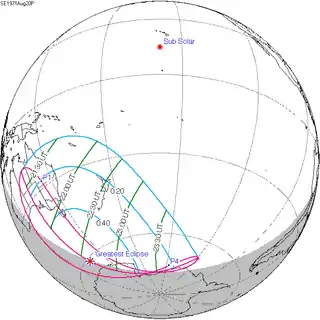 1971 August 20 Partial | -1.26591 | |
| A partial solar eclipse of July 22, 1971 occurs in the next lunar year set. | ||||||
Metonic series
The metonic series repeats eclipses every 19 years (6939.69 days), lasting about 5 cycles. Eclipses occur in nearly the same calendar date. In addition, the octon subseries repeats 1/5 of that or every 3.8 years (1387.94 days).
| 21 eclipse events between July 21, 1906 and July 20, 1982 | ||||
|---|---|---|---|---|
| July 20–21 | May 9 | February 24–25 | December 13–14 | October 1–2 |
| 105 | 107 | 109 | 111 | 113 |
 December 13, 1898 |
||||
| 115 | 117 | 119 | 121 | 123 |
 July 21, 1906 |
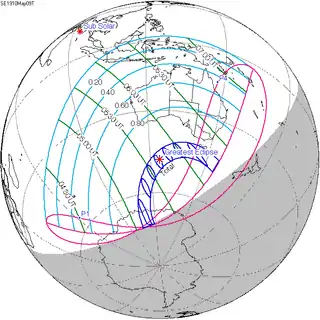 May 9, 1910 |
 February 25, 1914 |
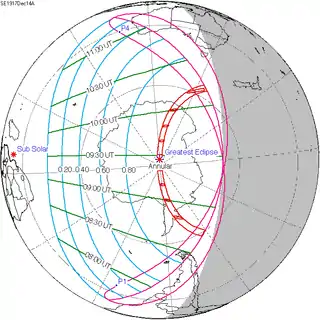 December 14, 1917 |
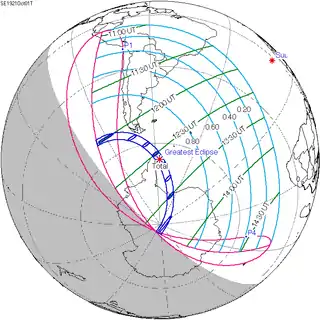 October 1, 1921 |
| 125 | 127 | 129 | 131 | 133 |
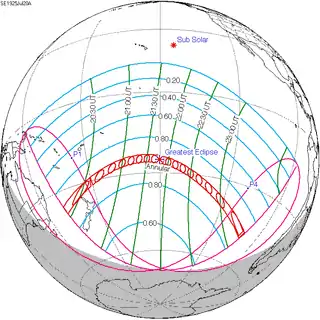 July 20, 1925 |
 May 9, 1929 |
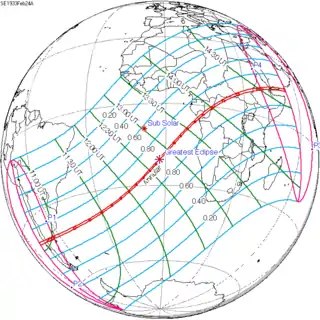 February 24, 1933 |
 December 13, 1936 |
 October 1, 1940 |
| 135 | 137 | 139 | 141 | 143 |
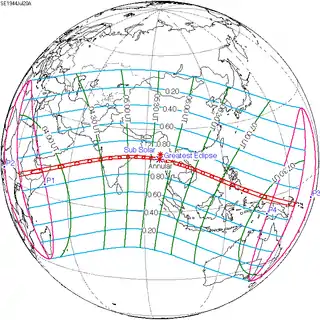 July 20, 1944 |
 May 9, 1948 |
 February 25, 1952 |
 December 14, 1955 |
 October 2, 1959 |
| 145 | 147 | 149 | 151 | 153 |
 July 20, 1963 |
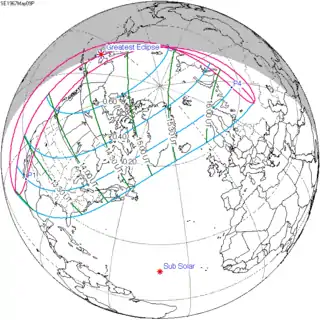 May 9, 1967 |
 February 25, 1971 |
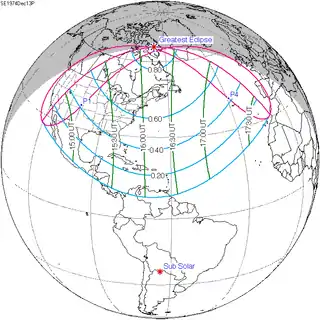 December 13, 1974 |
 October 2, 1978 |
| 155 | ||||
 July 20, 1982 | ||||
References
- van Gent, R.H. "Solar- and Lunar-Eclipse Predictions from Antiquity to the Present". A Catalogue of Eclipse Cycles. Utrecht University. Retrieved 6 October 2018.
External links
- Earth visibility chart and eclipse statistics Eclipse Predictions by Fred Espenak, NASA/GSFC
| Wikimedia Commons has media related to Solar eclipse of 1971 February 25. |
.jpg.webp)

